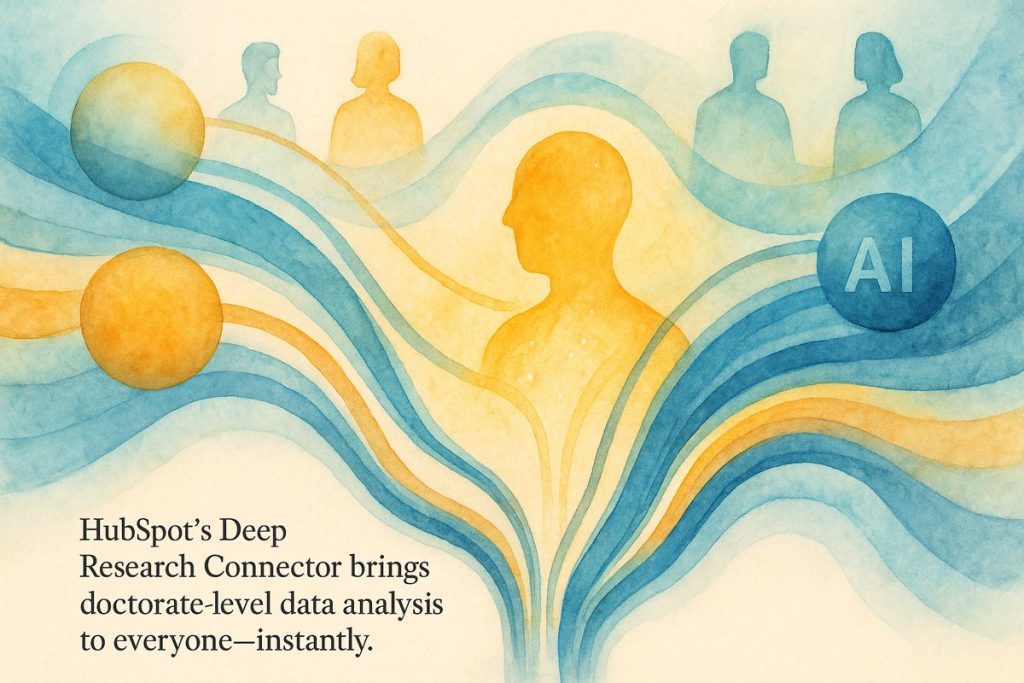HubSpot’s Deep Research Connector for ChatGPT changes the game in 2025 by letting anyone talk to their CRM with plain words and get smart, instant answers—no tech magic needed. Instead of digging through confusing dashboards, users just type questions and get clear, helpful insights in seconds, like asking a friend for advice. Now, sales teams, marketers, and even interns can quickly find the data they need to make decisions, all from a simple chat window. Security stays tight, but the power to understand and use company data is finally in everyone’s hands, not just the experts.
What is HubSpot’s Deep Research Connector for ChatGPT and how does it improve CRM data access in 2025?
HubSpot’s Deep Research Connector for ChatGPT revolutionizes CRM data access by allowing users to query their CRM in plain language. Instantly receive actionable, context-rich insights—no data analyst or coding required. This AI-powered tool democratizes data, enabling teams across sales, marketing, and operations to make smarter, faster decisions.
The CRM Labyrinth: Data, Data Everywhere
I’ll admit it right off the bat—CRM systems are a bit like those endlessly sprawling Moscow subway maps: routes everywhere, but figuring out the best path? That’s another story. HubSpot, Salesforce, Zoho—take your pick, they all promise to be the central nervous system for your customer operations. But for years, actually wrangling actionable insights from that palimpsest of contacts, deals, and cryptic support logs has required either a data analyst, an oracle, or a very patient intern. Cue 2025: HubSpot slides a hot cup of AI on the table—its Deep Research Connector for ChatGPT, and suddenly, CRM data gets a lot less claustrophobic.
The Deep Research Connector isn’t your garden-variety plugin. It’s the first of its kind: a hyperspectral bridge between ChatGPT’s conversational prowess and your CRM’s raw innards. Instead of pecking at old-school dashboards or deciphering SQL incantations, users casually type, “Which deals over $30,000 in the last fiscal quarter are still open?” or “What’s the average ticket resolution time in our EMEA region?”—and, like magic, context-rich answers pop up in seconds. I had to stop and ask myself: is this the data democratization folks have been promising since the days of Clippy?
Still, early on, I fumbled with a query—typed a rambling request and got a squirrelly result. But after a tweak or two (brevity, as ever, is queen), the insights came pouring out like a fresh Chemex brew. Relief? Check. Slight embarrassment? Also check.
From Query to Clarity: A Sensory Shift
Let’s talk specifics. Picture the sound of a coffee grinder—steady, granular, never rushed. That’s how the Deep Research Connector processes natural language queries. No more wrestling with pivot tables or waiting days for the “BI team” to reply. Just type, and the answer arrives—sometimes before you’ve even finished your croissant. I felt genuine delight the first time I watched a harried sales manager get her answer about Q2 SaaS leads before she even sipped her latte. Bam.
Why is this a big deal? For one, not everyone speaks “spreadsheet.” The connector parses English (or Russian, if you’re feeling nostalgic), maps intent, and hoists the right chunk of CRM data into the light. I once asked, “Which customers churned within 90 days after onboarding?” and—no lie—got a neat, color-coded list faster than I could say “retention crisis.”
But the real alchemy is in how this tool levels the playing field. Traditionally, only Fortune 500s with full-time data priests (hello, McKinsey) could sift for these insights. Now, a marketing intern at a 15-person startup can analyze campaign segments or spot anomalous buying patterns, all from the same chat interface they use to order team lunch.
There’s a certain egalitarian thrill to it, as if someone handed out the keys to the castle after years of peering through the gate.
Use Cases: Across Departments, From Whisper to Roar
The practical implications would make even the most jaded operations lead arch an eyebrow. Sales teams can filter their pipeline to surface only software sector accounts with high-ticket deals—no more haystacks, just needles. Marketers, meanwhile, can segment audiences by behavior, taste, or even channel (I still remember the “aha” when a colleague found out that our TikTok leads closed faster than anyone expected—go figure). And for customer success? Imagine forecasting support surges before tickets even arrive, like hearing the distant rumble of a storm before the first drop.
HubSpot’s developer blog explains how the underlying engine doesn’t just fetch structured data; it can parse unstructured notes and sentiment, surfacing trends you’d otherwise miss. Need to spot which sales calls are triggering churn? The connector listens, sifts, and flags.
Operations folks—usually the last to the analytics party—can now run trend analyses or hypothesis tests without waiting for IT handholding. I once watched our COO, notorious for his impatience, run a quarterly forecast and—get this—smile. That’s rarer than spotting a snow leopard in Sochi.
Guardrails, Security, and the Road Ahead
Let’s not ignore the elephant in the server room: data security. CRM records are as confidential as KGB dossiers, and HubSpot knows it. The connector respects all existing data permissions—so the intern won’t accidentally stumble on C-suite secrets. Encryption, audit logs, compliance frameworks—it’s all there, humming quietly in the background while you vibe to your own analytics groove. I do wonder, sometimes, what would happen if permissions got tangled, but—so far—nothing’s slipped past the tripwires.
What about taking action? Here’s where the integration really shines. Say you uncover a cluster of at-risk customers: with two clicks, you can launch a tailored nurture campaign or flag accounts for the customer success team. No toggling between a dozen tabs. It’s like having a sous-chef who not only dices the onions but also preps the pan.
And lest you think this is just for techies—HubSpot claims mass adoption across its user base, from junior marketers to grizzled sales veterans. No new certifications, no Excel wizardry required.
I did hear of one old-school VP who grumbled about “AI taking our
